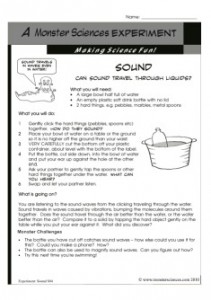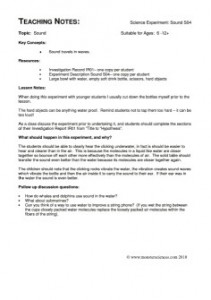Make your own hydrophone to listen for sounds underwater.
 |
 |
Monster Sciences Sound Experiment: Can you hear underwater?
What you will need:
- A large bowl half full of water
- An empty plastic soft drink bottle with no lid
- 2 hard things, e.g. pebbles, marbles, metal spoons
What you will do:
- Gently click the hard things (pebbles, spoons etc) together. How do they sound?
- Place your bowl of water on a table or the ground so it is no higher off the ground than your waist.
- VERY CAREFULLY cut the bottom off your plastic container, about level with the bottom of the label.
- Put the bottle, cut side down, into the bowl of water and put your ear up against the hole at the other end.
- Ask your partner to gently tap the spoons or other hard things together under the water. What can you hear?
- Swap and let your partner listen.
What is going on?
You are listening to the sound waves from the clicking traveling through the water. Sound travels in waves caused by vibrations, bumping the molecules around them together. Does the sound travel through the air better than the water, or the water better than the air? Compare it to a solid by tapping the hard object gently on the table while you put your ear against it. What did you discover?
Monster Challenges:
- The bottle you have cut off catches sound waves – how else could you use it for this? Could you make a phone? How?
- The bottle can also be used to magnify sound waves. Can you figure out how?
- Try this next time you’re swimming!
Teaching Notes:
Topic:
Sound
Key Concepts:
Sound travels in waves.
Resources:
- Investigation Record IR01– one copy per student
- Experiment Description Sound S04– one copy per student
- Large bowl with water, empty soft drink bottle, scissors, hard objects
Lesson Notes:
When doing this experiment with younger students I usually cut down the bottles myself prior to the lesson.
The hard objects can be anything water proof. Remind students not to tap them too hard – it can be too loud!
As a class discuss the experiment prior to undertaking it, and students should complete the sections of their Investigation Report IR01 from ”Title to “Hypothesis”.
What should happen in this experiment, and why?
The students should be able to clearly hear the clicking underwater, in fact is should be easier to hear and clearer than in the air. This is because the molecules in a liquid like water are closer together so bounce off each other more effectively than the molecules of air. The solid table should transfer the sound even better than the water because its molecules are closer together again.
The children should note that the clicking rocks vibrate the water, the vibration creates sound waves which vibrate the bottle and then the air inside it to carry the sound to their ear. If their ear was in the water the sound is even better.
Follow up discussion questions:
- How do whales and dolphins use sound in the water?
- What about submarines?
- Can you think of a way to use water to improve a string phone? (If you wet the string between the cups closely packed water molecules replace the loosely packed air molecules within the fibers of the string).



